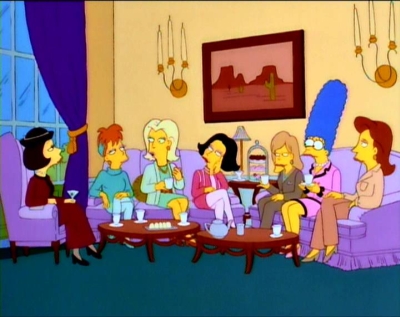The Class Struggle in Springfield
In the episode of The Simpsons -- "The class struggle in Springfield", Marge becomes the typical representation of those who are having "American Dreams". They believe that all of the efforts you put will eventually lead you to success no matter what, so as long as you work hard enough, you will have the wealth, the status or the goal that you desire. This is reflected on how Marge acts when she gets invited to the club where the upper-class (or the bourgeoises) hangs out.
We can observe that in her four actions:
First, she demands her family to dress formally and to be well-behaved in the club, in order not to lose face.
Second, when she is in the club, drinking with other women, she puts on a fake smile to whatever they say, even if she is not understanding or agreeing with them.
Third, with lots of social events happening in the upper-class society, she has to trim her "exquisite and high quality" suit over and over again. Just in case no one notices that it is the only outfit that is suitable for their events.
Last, when she accidentally screws up the suit, she not only drives all the way to the outlet and tries to find another "high-end" substitute, but also spends all their family savings for a brand-new Chanel gown from the original store.
She thinks that all of the attempts will promise her to get her and her family into the upper class, but she also loses sights of reality.
However, there are actually two characters that fulfill American Dreams, who find their ways of transcending into a higher class that they did not start with -- Mr. Burns Krusty the Clown. They are the "tokens" in this show.
Having and running his own nuclear plant, Mr. Burn is certainly considered as a bourgeoise. Nevertheless, his personality and temperament seem incompatible with the "ideal" image of how upper-class groups should be like.
As for Krusty the clown, he keeps appearing in the club's golf court in this episode. However, he actually started with the background of being a Jewish, which can be considered as a racial minority and doing mime on the street. He, then, beings to have his own telethons and become a celebrity. This makes him able to join the club where people with money and power go. His situation is the true illustration of tokenism.
These two characters seem unsuitable with the upper class, but the only thing they have in common is that they both have MONEY.
In this episode, it also promotes the ideology of "conspicuous consumption", which is the idea of people thinking that by purchasing "better" material goods or services, it allows them to be a member of the upper class. However, what does it mean by "better"? It relates to another idea - "commodity fetishism". It defines commodities' value through their relationships with the money, which sometimes gives them the additional unrealistic significance of what they usually worth. For instance, it is reflected on the moment when Marge sees the Chanel tag of the suit and gasps in admiration.
The episode amplifies the ideology of conspicuous consumption through the scene when Marge's friend sees her wearing the high-end suit in the gas station and invites her to join the club. This gives audiences the idea of "buying or possessing something the upper-class has will make them think that you are one of them."
On top of all these, the episode actually approves the capitalist point when the Simpsons go into the club to meet the rich, only Marge steps into the room while others just standing at the entrance as if they were servants. This shows that awkwardness of the class distinction.
Also, at the very end of the episode, the whole family go to Krusty’s diner and find “the sense of belonging”. It replies that the proletarians should stay and be used to where they “belong”.
I guess let’s just end this post with Homer’s classic line:






Comments
Post a Comment